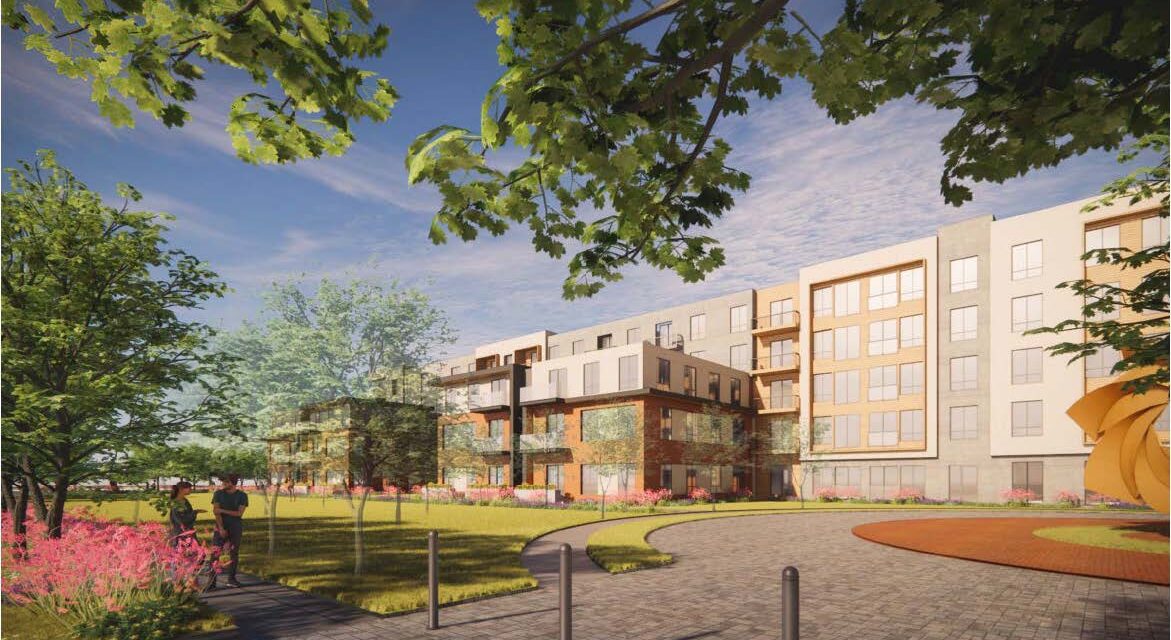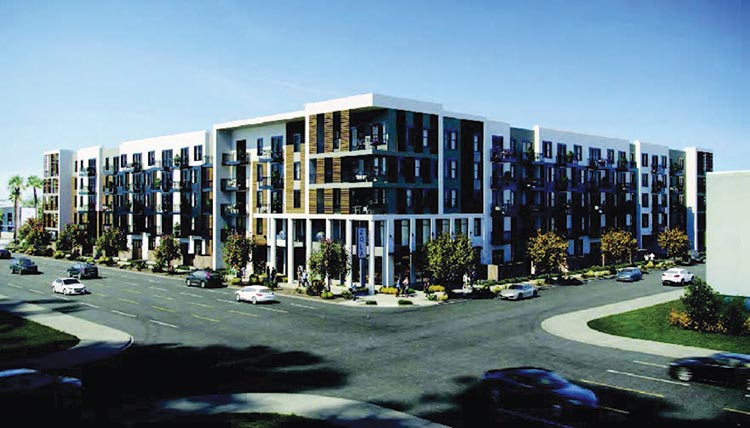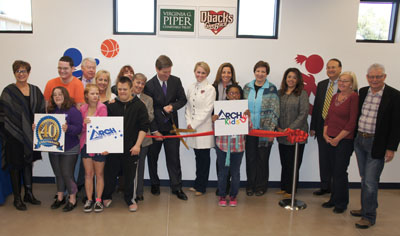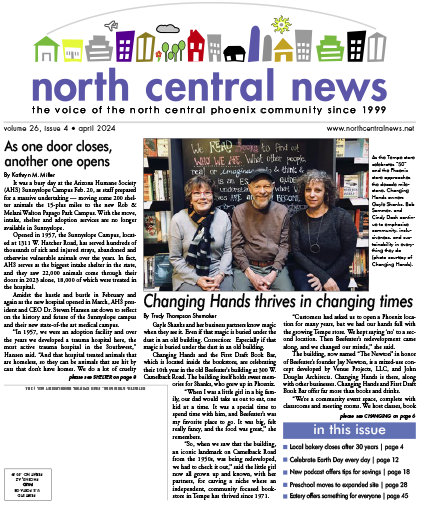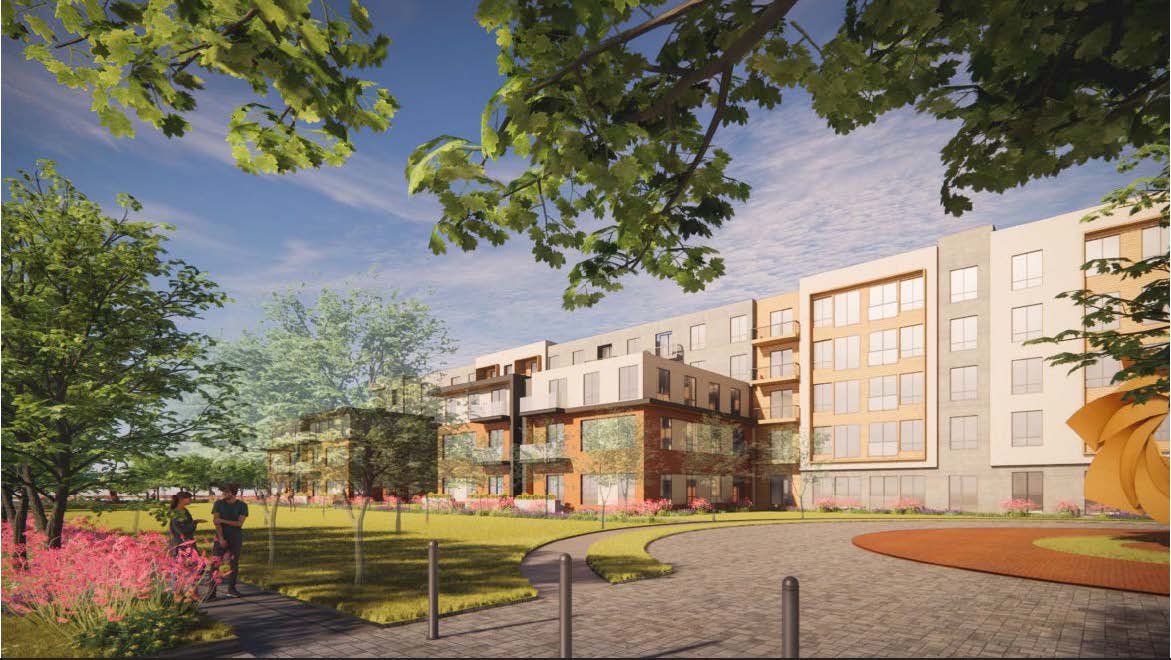
A rendering shows the planned green space along 2nd Avenue, between Glenrosa and Turney avenues (photo courtesy of Petree Development, LLC).
At a June 5 meeting of the Encanto Village Planning Committee (VPC), Petree Properties, the developer behind the 15-acre plot of vacant land on the northwest corner of Central and Glenrosa avenues, made their pitch and cleared the first hurdle in the public approval process. The committee approved the rezoning request based on the Planning Department’s report, with its 33 stipulations and the developer’s 11 last-minute proposed stipulations, by a 10-2 vote. The approval, however, was not without contention and it has left some soured on the process as a whole.
The property sits between Glenrosa and Turney Avenue and runs from Central to 2nd Avenue. It has been held by the same owners for more than 30 years and it has been largely vacant during that time, with the exception of the five years that Agave Farms took up residence.
For the past 18 months, the developer has worked to bring the project to its current point, a request to rezone the 15.61 acres to Walkable Urban (WU) Code with various height transects to allow a mixed-use development with 1,500 residential units. Petree says that the development conforms to the Uptown TOD (Transit Oriented Development) Policy plan; creates a walkable, sustainable, dense development that maximizes the community’s investment in light-rail; and transitions into and becomes part of the Carnation neighborhood.
“We were very pleased by the 10-2 vote in support or our plan at Central & Glenrosa, and even more pleased to have earned support from the Carnation neighborhood,” said Wendy Riddell, who represented Petree at the VPC meeting. “The developer has gone to extraordinary lengths to provide substantial benefits to the Carnation neighborhood… We have worked on this project and with the neighbors for over a year and a half, and their input has led to significant changes resulting in a project that benefits everyone.”
During those 18 months, the Carnation Association of Neighbors (CAN) has held 13 development committee meetings, some with Petree, and the development has been the subject of every general membership meeting for the past year, Cliff Valenti said in his June 5 remarks to the VPC.
“I have to say, it has been a frustrating process because for so long Petree has been unwilling to budge on a project that was already designed before they even spoke to the community,” said Valenti, who serves as the CAN development committee chair. “However, over the last week Petree Properties has made many serious concessions, and I stand before you today with a renewed sense of excitement. While these changes are too recent to be able to say the neighborhood as a whole supports the project, I am confident that these concessions are consistent with what we have been asking.”
Those concessions include 20,000 square feet of commercial space — not the 30-50,000 that neighbors asked for, but more than the 7,000 that the plan called for up until the June meeting. Petree also reduced the density by 100 units, capping it at 1,500. They also closed the Montecito Alignment, which will prevent development traffic from exiting directly onto 2nd Avenue and into the neighborhood. In place of an entry will be an expanded greenspace. Other commitments made by the developer include sharing the design at each phase (there will be four) through the VPC and other public processes, as well as sharing the design of public art. They also have said that they will install sidewalks in the adjacent neighborhood as well as traffic calming and mitigation to lessen the traffic impact on neighbors.
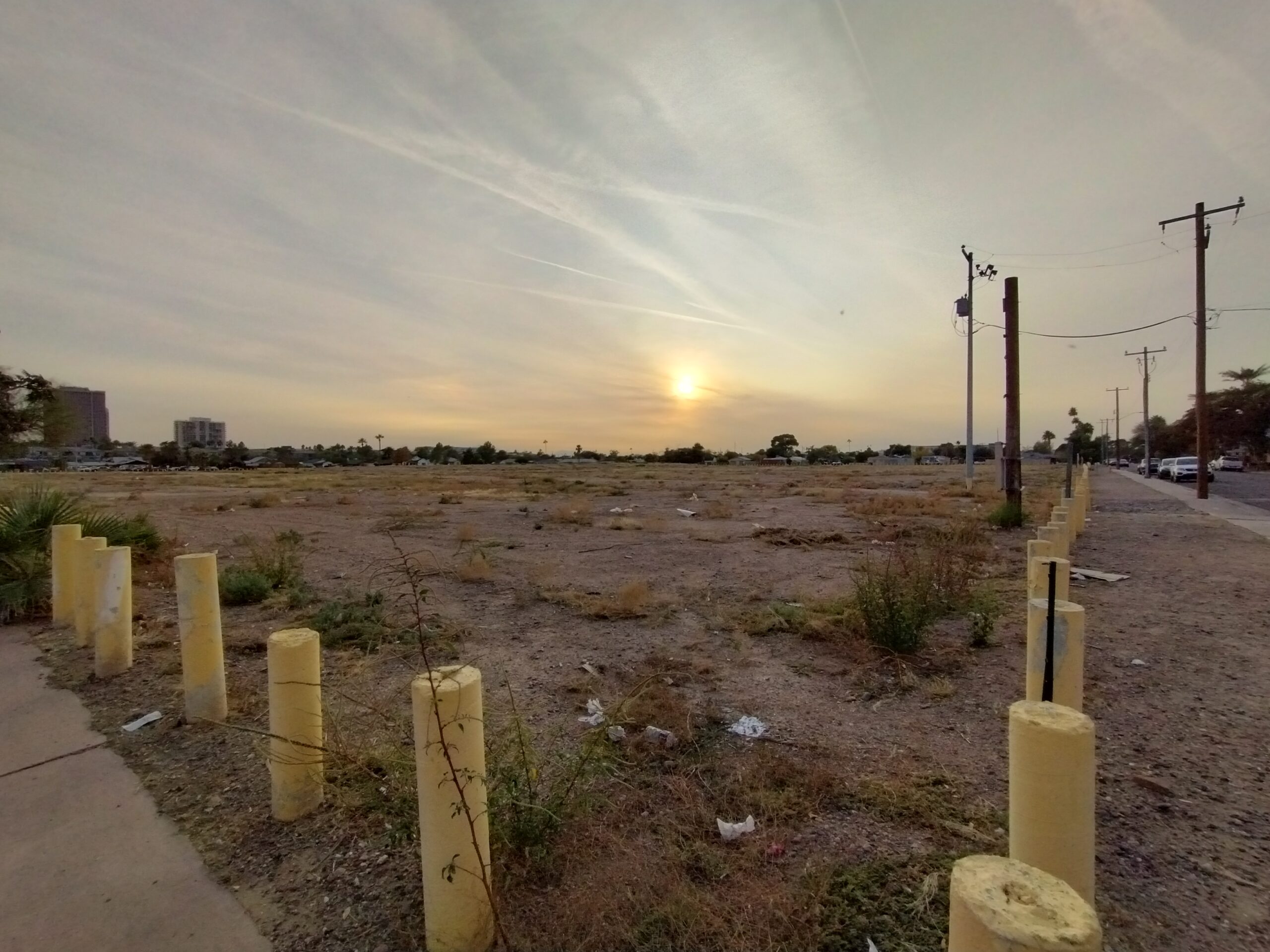
The 15-acre lot on the west side of Central Avenue between Turney and Glenrosa avenues, which has been largely vacant for nearly 30 years, will be developed to include 1,500 residential units (photo by Kathryn M. Miller).
All of these elements are welcome, but not enough for some neighbors who are still concerned about the height adjacent to single family homes (the phases will consist of 60-, 85-, 240- and 70-foot-tall buildings, with 40- and 30-foot height limitations next to single family homes) and the impact that the density will bring to the area. And the long process has been less than stellar.
“Planning did a terrible job, and our city council needs to increase their oversight of this important institution,” Valenti said after the meeting. “Had they really used Reinvent PHX as a framework, everything about this project would be better. The Encanto VPC did impress me with many of their questions, but I also believe they need to be more open to what is stated in Reinvent PHX.”
Julie Hampton, who was president of CAN at the time of the VPC meeting, said that she was “reluctantly optimistic” about the project after the last-minute concessions but agreed with Valenti on the process.
“I echo Cliff’s sentiments about the city being difficult to work with to uphold the Reinvent PHX Plan adopted in 2015. Neighborhood associations shouldn’t have to spend this much time and energy to secure stipulations from developers for an integrated, mixed use, walkable project when stakeholders already came together 10 years ago to outline that vision for the Central corridor.”
Many neighbors agree that the city departments need to work together in a more holistic manner with both the neighbors and developers together at the same time instead of in a “siloed” manner, as Hampton described it.
Kim Jennings, who has lived in Carnation for the past eight years goes further.
“I’m sad to say that the city that I call home has let down the Carnation community,” Jennings said after the meeting. “While the city’s mission is to improve the quality of life in Phoenix through efficient delivery of outstanding public services it has failed us deeply.
“All I hear from builders is that we live in the city and need to accept density, but we are past density and now in crisis. Our streets are already beyond capacity and unsafe. Now let’s add a complex that’s over 1,500 units and an average of 3,000 more cars coming through our neighborhood,” Jennings said, then asked of city planners, “Have you taken a step back to see if what the land is zoned for is good for the communities?”
While a Planning Department spokesperson said that they could not comment on the case during the public approval process, the question posed is not a new one, and much of the criticism of projects along Central Avenue stems for a lack of adherence to the vision of Reinvent PHX, which was established in 2015 with one main goal: Walkable, opportunity-rich communities. And TODs are meant to “Maximize the benefits of light rail by guiding development to improve the quality of life, lower the cost of living, and enhance unique and historic characteristics.”
Another resident voicing concern is Jeremy Thacker, who not only lives in the Carnation neighborhood but sat on the Encanto VPC.
“Even with everything that they’ve done, this is by no definition of the word a walkable community,” Thacker, who voted against the project, said after the meeting.
Thacker said that a defining characteristic of walkable urban neighborhoods, along with diversity in both the housing and the people inhabiting it, is small parcels.
“These are giant parcels. And along with those giant parcels come other issues that are almost impossible to resolve otherwise — the ability to slow down traffic and eliminate cars,” he said, adding that he doesn’t see how the target demographic will increase transit ridership.
Speaking to resident concerns about lack of mixed-use elements in many new Central Avenue projects, Thacker added, “I think they’re making a huge mistake. With the amount of density that we’ve got going in now, we will become the most dense residential half-mile in the city once all of the developments have been completed. That means that there’s going to be a huge need for commercial, not just a desire for it from the neighbors.”
Of the process, Thacker said that developments should have an advocate who can work with developers on behalf of neighbors and added, “I think the Encanto Village Planning Committee is made up of a lot of people who live in neighborhoods who… this project would never possibly be allowed due to the restrictions that they’ve got in place.”
Thacker resigned his committee seat after the June 5 meeting.
Ed Hermes, who was elected as president of CAN June 12, says that many of the elements that make the neighborhood special are its proximity to Melrose, its diversity of people, housing and businesses, as well as its pro-public transit attitude. The neighborhood is also pro walking and biking and neighbors want to be able to do those activities safely.
“There’s always going to be a bit of trepidation when it’s a project of this size, but I think the general feeling in the room was excitement and acknowledgment that there’s still going to be a lot of work to do to see this through, especially the traffic mitigation,” Hermes said. “But we also understand that the city Streets department requires quite a few signatures from our neighbors to actually make it happen, which we are committed to doing.”
The Planning Commission will hear the rezoning case Aug. 3, followed by the City Council on Sept. 6. In the meantime, residents hope that city leaders will be more receptive to their concerns as this and other projects move forward.
“It takes vision and courage from our leaders to change the status quo,” Hampton added, “but it’s what Phoenix needs.”

